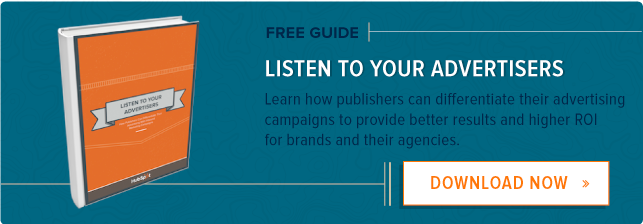

Marketers are facing a proliferation of digital channels, the rise of the connected consumer, and an onslaught of new digital formats and tools. All of this can make pitching clients on the merits of one marketing channel over another quite difficult.
It helps to know what these folks care about. As an agency, you're in a unique position to answer this question. Your clients are, for the most part, concerned with a few key things: demonstrating ROI, targeting specified audiences, improving customer engagement, and dealing with the explosion of customer touch points.
This is by no means an exhaustive list, but it gets at the heart of the matter: Advertisers want to break through the clutter and ensure their ads are being seen by targeted readers. Lucky for you, programmatic native advertising excels in each of these areas.
3 Reasons Why Brands Love Native Advertising
1) Demonstrating ROI
Over the past few years native advertising has emerged as a compelling alternative to mobile banner tactics, turning an environment hostile to display into one that feels just like home. At the center of this? A higher ROI.
Call it “banner blindness” or “banner noise,” it’s common knowledge that banner ads, once the hallmark of digital advertising, don’t perform like they used to. In the U.S., the average click-through rate (CTR) for display ads is 0.08%, while 15 years ago, it was 0.9%.
The reasons for this are fairly simple. While the digital advertising industry has grown and evolved since banner ads were first introduced back in 1993-1994, banner ads themselves have remained almost entirely unchanged. They’re non-interactive, inflexible, intrusive, and people just don’t click on them anymore.
When advertisers became savvy to these facts, they started looking for new ways to engage with their online audiences. Low and behold, native advertising was born.
The numbers for native advertising are hard to argue with: Consumers look at native ads 52% more frequently than banner ads, native advertising generates 85-93% more clicks than banner ads, and purchase intent is 53% higher for native ads.
Not only does native advertising enhance consumer experience and raise brand affinity by offering non-disruptive, contextually relevant content, but it optimizes the purchase pathway for brands as well. And this is particularly true when a native advertising campaign is tied to a pre-existing content marketing strategy. In fact, adding rich media to native ads can boost conversion rates by up to 60%.
2) Targeting & Customer Engagement
The sales funnel is something we’re hopefully all familiar with. But for the uninitiated, it’s a visual metaphor used to describe the sales process from the perspective of the customer. The stages in the funnel refer to a potential customer’s degree of readiness in the sales cycle: awareness, affinity, intent, and purchase.
A bottom-line issue that every advertiser should care about is customer engagement -- the on-going, meaningful contact and mutually beneficial interaction with your customers at various stages of the sales cycle.
This is one area where native adverting really shines. The customer targeting abilities of native advertising makes it the perfect companion to branded content, particularly branded content that resonates with specific personalities at various stages of the sales cycle. Why? Because hyper-relevancy is more important today than ever before.
This is one of the key advantages of programmatic native advertising: the ability to eliminate display waste. When done right, native advertising can help you serve ads only to users who are likely to perform a certain action.
Think of it this way: A travel agency creates a piece of branded content with the goal of helping readers plan a trip. The content is inspirational, educational, and destination-specific, and the brand wants it to be read by a specific sub-set of readers -- perhaps Californians who have already expressed an interest in visiting that destination. By running a programmatic native advertising campaign, the travel agency can promote its content to that very targeted audience via contextually relevant ads that are delivered to readers based on their geographical location.
This is just a taste of programmatic’s advanced targeting abilities, which include contextual and audience targeting, geographic targeting, language targeting, conversion tracking, and more.
3) Explosion of Touch Points
With so much of digital time now taking place on mobile devices, smart advertisers are quickly shifting budgets from desktop to mobile ads. According to Digiday, mobile display revenue is outpacing desktop ad spend and is expected to surpass it by 2018.
However, advertisers are also realizing that the standard banner ads they have been using on display elicit a much weaker response on mobile. Why? Because we don’t interact with our mobile phones the same way we do with our desktop computers.
Native ads on mobile deliver exactly what every advertiser wants: maximum returns at a minimum cost. This is a key point to make when getting your clients on board with native advertising.
Why Native Is Solving Mobile Advertising Issues
1) Native ads transfer better to mobile than banner ads.
Native mobile ads match the content that surrounds them in terms of look, style, and feel. And when they’re done well, mobile native ads can complement and positively contribute to the pages they appear upon by enhancing user experience and providing value for customers.
2) Native ads are more flexible in terms of style and appearance than banner ads.
Banner ads are bought in a fixed, rectangular configuration, and their placement is equally as inflexible. Mobile native ads, on the other hand, offer plenty of flexibility to play around with the appearance and positioning of an ad.
3) Native ads are more effective at catching user attention than banner ads.
According to research by Sharethrough and Nielsen, native mobile ads draw substantially more user attention than banner ads. Readers are more engaged by native ads, which makes them more likely to spend time reading them.
We haven’t included it as a point here, but if your clients aren’t creating branded content yet, they need to get started soon. Content marketing is a powerful tool that more and more brands are using to connect with their users. And while running native advertising campaigns is beneficial to brands in multiple contexts, its efficacy really shines through when it’s used to promote content.
Native Advertising
